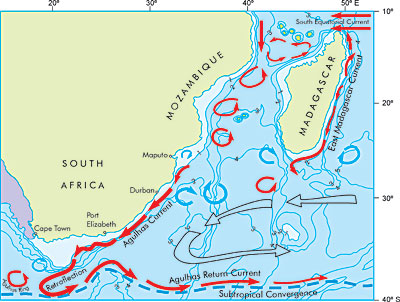Welcome to the ASCLME Project
 Between 2008 and 2013, the nine countries of the western Indian Ocean region, including Comoros, Kenya, Madagascar, Mauritius, Mozambique, Seychelles, Somalia, South Africa and Tanzania, will work together through the UNDP supported GEF financed Agulhas and Somali Current Large Marine Ecosystems (ASCLME) Project.
Between 2008 and 2013, the nine countries of the western Indian Ocean region, including Comoros, Kenya, Madagascar, Mauritius, Mozambique, Seychelles, Somalia, South Africa and Tanzania, will work together through the UNDP supported GEF financed Agulhas and Somali Current Large Marine Ecosystems (ASCLME) Project.
Agulhas Current system
The Agulhas Current system may be considered to consist of three components: a source region, the northern Agulhas Current proper and the southern Agulhas Current. The sources of the Agulhas Current are the subtropical gyre of the south Indian Ocean, the region east of Madagascar and the Mozambique Channel. Of these, the subtropical gyre is the main contributor by volume. The flow through the Mozambique Channel consists largely of intense, anti-cyclonic eddies that are formed in the narrows of the channel and that move poleward from there. These eddies may be 200km in diameter and extend all the way to the sea floor. Their influence on adjacent shelf regions is not known.

Between the narrows of the channel and the Comoros Islands, the flow seems to be in the form of an anti-cyclonic gyre, but this conclusion is based on very few observations and the flow may in fact be quite variable. The currents on the eastern side of the channel, outside the direct influence of the Mozambique eddies, are unknown. There are some observations that suggest a net southward movement, but other measurements indicate a northward movement. Remote sensing data have shown the presence of weak eddies in this region that draw water off the shelf. Whether this is an important process from a chemical and biological point of view is not yet known. In fact, there are no published observations of currents on this shelf region whatsoever.
The flow along the east coast of Madagascar is equally poorly known. A fast and intense current, the East Madagascar Current carries water along the edge of the narrow continental shelf. The southern part of this current goes poleward; the northern component equatorward. The location of the bifurcation is not known with any degree of accuracy. Since the shelf is so narrow it may be assumed that the water on the shelf moves in sympathy with the juxtapositioned current, but to date there are no observations to adequately support this hypothesis. Both along the shelf of Mozambique and the shelf of Madagascar, upwelling cells with enhanced nutrient contents have been observed. These include a cell off the Delagoa Bight along the Mozambican coast and at near Angoche on the southeast coast of Madagascar. The intensity and the persistence of these cells, as well as their biological impact, needs to be determined.
The northern Agulhas Current seems to start somewhere between the cities of Durban and Maputo, according to evidence gleaned from the movement of sediments on the adjacent shelf. The current is strong, intense and increases in depth and in volume flux downstream. Maximum velocities exceed 2m/s on its inshore side; the current being 60 to 100 km wide with an intense inshore edge but a more dispersed offshore border. The current follows the shelf edge quite closely, diverging from the coastline where the continental shelf is wide, such as at the Natal Bight. In general, the trajectory of the current is unusually stable for a current of this nature, the exception occurring during the passage along the current of a Natal pulse. This singular meander commences at the Natal Bight and from there moves down the current at about 20 km/day, growing in amplitude. The coastal effect of the passage of a Natal Pulse is a sudden, but short-lived reversal in current directions. On the whole, the water movement on the adjacent shelf is parallel and in the same direction as the northern Agulhas Current. There are two exceptions: directly south of Durban and over the Natal Bight. South of Durban there is a persistent lee eddy that may be carried off in an incipient Natal Pulse; on the Natal Bight the water movement may be largely dependent on the reigning wind.
At the northern tip of the Natal Bight there is a concentrated and persistent upwelling cell that probably supplies a major part of the bottom water for this part of the shelf. It enhances the local nutrient supply and leads to a marked increase in local phytoplankton density. The precise role of this point source of nutrients for the ecosystem of the region has not been studied.
The path of the southern Agulhas Current – downstream of the city of Port Elizabeth – is much less stable, exhibits meanders as well as attendant shear edge eddies and plumes. It flows past the wide Agulhas Bank and has a decisive influence on this shelf’s water masses. At the eastern corner of the Agulhas Bank there is a persistent upwelling cell. It has been inferred that this cell supplies all the nutrient rich bottom water for the bank. It also enhances the seasonal thermocline. This process may be crucial for the successful spawning of the major pelagic fish species that have been shown to preferentially produce their eggs on this bank. From here the larvae and sprat move to the Benguela upwelling system of the south Atlantic Ocean to support the largest fisheries of the region – therefore a true transboundary ecosystem.



